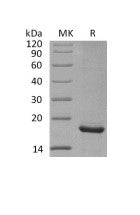1
/
of
2
Recombinant Mouse Endostatin (C-6His)
Recombinant Mouse Endostatin (C-6His)
Recombinant Mouse Collagen Alpha-1(XVIII) Chain is produced by our Mammalian expression system and the target gene encoding His1591-Lys1774 is expressed with a 6His tag at the C-terminus.
Catalog No:
EPT193
Regular price
$220.00 USD
Regular price
$169.00 USD
Sale price
$220.00 USD
Unit price
/
per
Couldn't load pickup availability
Product Details
Accession
P39061
Molecular Weight
21.2 KDa
Apparent Molecular Weight
18 KDa, reducing conditions
Purity
Greater than 95% as determined by reducing SDS-PAGE.
Endotoxin
Less than 0.1 ng/µg (1 EU/µg) as determined by LAL test.
Expression Host
Mammalian
Reconstitution
Always centrifuge tubes before opening.Do not mix by vortex or pipetting.
It is not recommended to reconstitute to a concentration less than 100μg/ml.
Dissolve the lyophilized protein in distilled water.
Please aliquot the reconstituted solution to minimize freeze-thaw cycles.
Shipping Condition
The product is shipped at ambient temperature. Upon receipt, store it immediately at the temperature listed in the Storage field.
Storage Condition and Shelf Life
Lyophilized protein should be stored at < -20C, though stable at room temperature for 3 weeks.
Reconstituted protein solution can be stored at 4-7°C for 2-7 days.
Aliquots of reconstituted samples are stable at < -20C for 3 months.
Background
Endostatin, an endogenous non‑glycosylated inhibitor of endothelial cell proliferation and angiogenesis. It is produced and/or trimmed by metalloproteinases such as MMP‑2 and MMP‑9, and cathepsins S, B and L. The N‑terminal ~27 aa of Endostatin appear to contain the majority of its activity. This region contains zinc binding sites that are thought to be critical for its anti‑endothelial and anti‑tumor effects, as well as multiple cleavage sites that, when used, can modify its activity. Mouse Endostatin shares 96% aa sequence identity with rat and 85‑87% with human, bovine and equine Endostatin. It is predominantly expressed in liver, kidney, lung, skeletal muscle and testis. Endostatin inhibits endothelial cell growth by inducing cell cycle arrest in G1 phase and initiating apoptosis. It is also thought to down‑regulate angiogenesis by blocking VEGF‑induced endothelial cell migration. Endostatin may also be involved with down‑regulation of angiogenesis after establishment of placental circulation in the pregnant uterus.
Analyte
Endostatin
Regulatory Status
For Research Use Only



